A well-crafted Leadership Development Plan (LDP) serves as a roadmap for nurturing and enhancing the skills and capabilities of current and future leaders. By systematically identifying and developing leadership potential, organizations can ensure sustained growth, resilience, and the ability to navigate complex challenges. An effective leadership development plan example not only aligns individual career aspirations with organizational goals but also fosters a culture of continuous improvement and innovation.
What is leadership development?
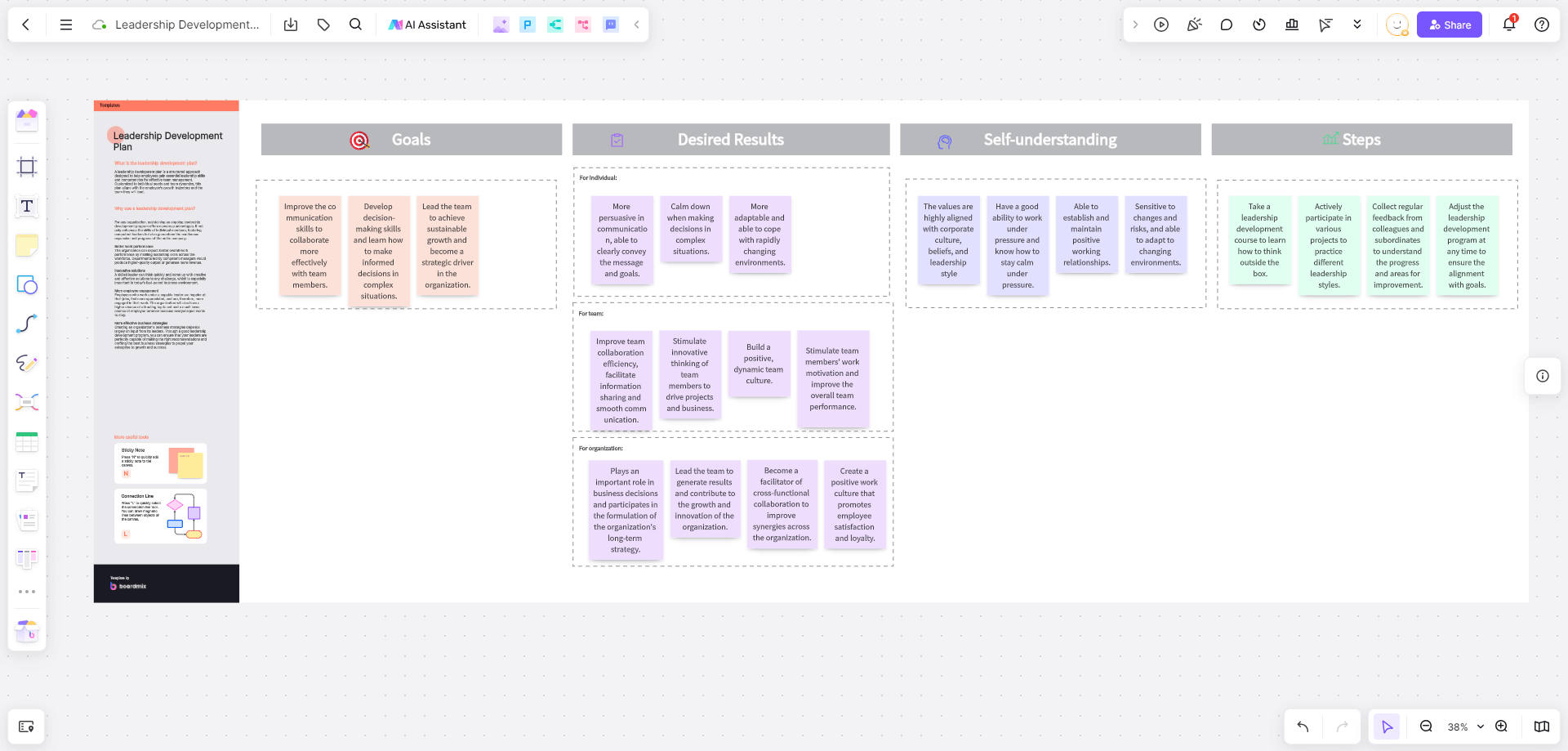
The primary objective of an LDP is to create a continuous learning environment where potential leaders can grow and thrive. In the context of modern businesses, leadership development is crucial for ensuring that an organization has a pipeline of capable leaders ready to take on future challenges.
In practical application, LDPs are tailored to align with an organization's goals and culture, often including personalized training, mentoring, and hands-on experience. Leadership development plans not only help in building specific leadership competencies but also contribute to employee retention, engagement, and overall organizational success. By investing in leadership development, companies can foster a culture of growth, innovation, and resilience. So company or individual needs to make leadership development plan templates for themselves.
What is the principle of leadership development plan templates?
Creating an effective Leadership Development Plan template requires adherence to certain guiding principles. These principles ensure that the plan is comprehensive, practical, and aligned with organizational goals. Here are the key principles:
1. Alignment with Organizational Goals
The leadership development plan should be closely tied to the strategic objectives of the organization. This ensures that the skills and competencies developed in leaders directly contribute to the company's success. By aligning with organizational goals, the plan can address specific challenges and opportunities faced by the organization.
2. Use SMART Guidelines
Goals should be Specific, Measurable, Actionable, Realistic, and Timely. Although crafting goals that meet each of these requirements can feel burdensome, the payoff will far exceed the upfront effort. Qualitative indicators along with appropriate business metrics should be used when specifying how leader behavior change is to be measured.
3. Individualized Development
Each leader has unique strengths, weaknesses, and career aspirations. An effective leadership development plan example should recognize these differences and offer personalized development opportunities. This could include customized training programs, one-on-one coaching, and career path planning. Individualized development ensures that each leader receives the support they need to grow in their specific role.
4. Competency-Based Framework
A competency-based approach identifies the key skills and behaviors required for effective leadership within the organization. By focusing on specific competencies such as strategic thinking, emotional intelligence, and communication, the leadership development plan template can target areas that will have the most significant impact on leadership effectiveness.
5. Continuous Feedback and Assessment
Regular feedback and assessment are critical for measuring progress and adjusting the development plan as needed. This involves not only self-assessment but also feedback from peers, supervisors, and direct reports. Continuous feedback helps leaders understand their progress, recognize areas for improvement, and stay motivated.
Examples of effective leadership development plan templates
360-Degree feedback development plan template
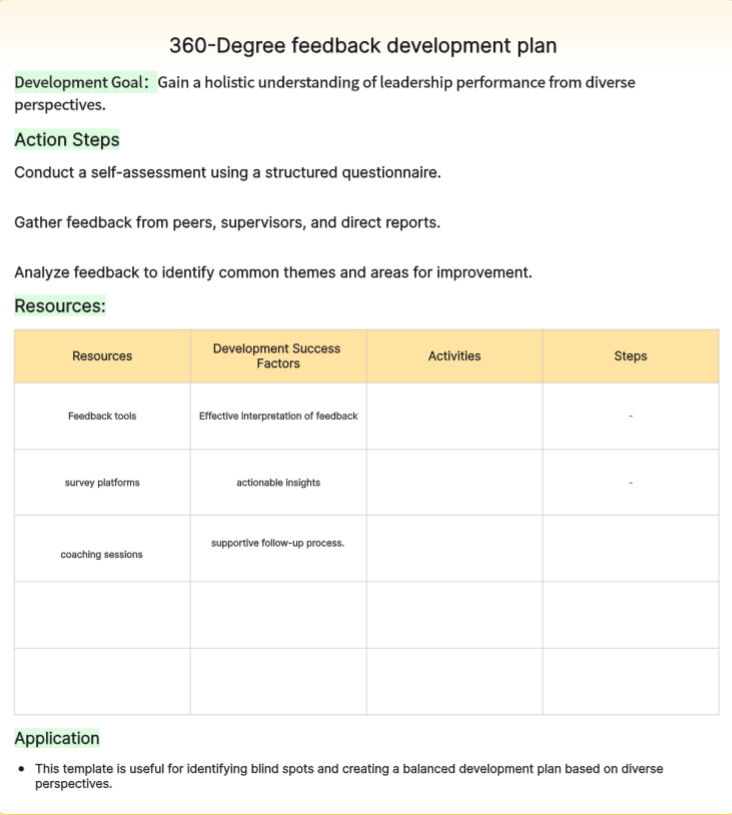
This template incorporates feedback from multiple sources to provide a comprehensive view of a leader's strengths and areas for improvement. It includes:
Development Goal: Gain a holistic understanding of leadership performance from diverse perspectives.
Action Steps:
- Conduct a self-assessment using a structured questionnaire.
- Gather feedback from peers, supervisors, and direct reports.
- Analyze feedback to identify common themes and areas for improvement.
Resources: Feedback tools, survey platforms, and coaching sessions.
Development Success Factors: Effective interpretation of feedback, actionable insights, and a supportive follow-up process.
Application: This template is useful for identifying blind spots and creating a balanced development plan based on diverse perspectives.
Individual development plan (IDP) template

An IDP is a personalized plan that outlines specific goals, required skills, and actions needed to achieve leadership objectives. It typically includes:
Development Goal: Align personal career aspirations with organizational needs.
Action Steps:
- Define short-term and long-term career goals.
- Identify necessary skills and competencies to develop.
- Create a detailed action plan with timelines and milestones.
Resources: Training programs, workshops, mentorship, and online courses.
Development Success Factors: Clear goal-setting, regular progress reviews, and alignment with career aspirations.
Application: The IDP is ideal for providing a clear roadmap for personal and professional growth.
Succession planning template

This template focuses on preparing leaders for future roles within the organization. It includes:
Development Goal: Ensure a pipeline of ready leaders for critical positions.
Action Steps:
- Identify key leadership positions that need succession planning.
- List potential candidates and assess their readiness.
- Develop specific action plans for each candidate, including training and development activities.
Resources: Talent assessment tools, development programs, and executive coaching.
Development Success Factors: Timely identification of successors, tailored development plans, and regular reassessment.
Application: Succession planning ensures a smooth transition of leadership and reduces the risk of leadership gaps.
Mentorship program template
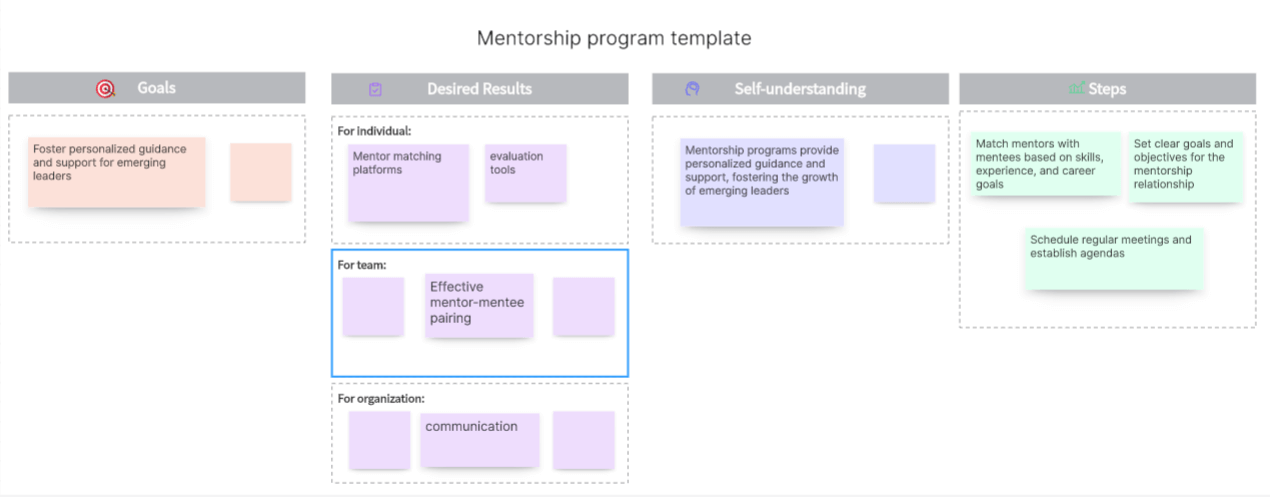
A structured mentorship program pairs emerging leaders with experienced mentors. The template includes:
Development Goal: Foster personalized guidance and support for emerging leaders.
Action Steps:
- Match mentors with mentees based on skills, experience, and career goals.
- Set clear goals and objectives for the mentorship relationship.
- Schedule regular meetings and establish agendas.
Resources: Mentor matching platforms, meeting schedules, and evaluation tools.
Development Success Factors: Effective mentor-mentee pairing, clear communication, and goal achievement.
Application: Mentorship programs provide personalized guidance and support, fostering the growth of emerging leaders.
Leadership training curriculum template
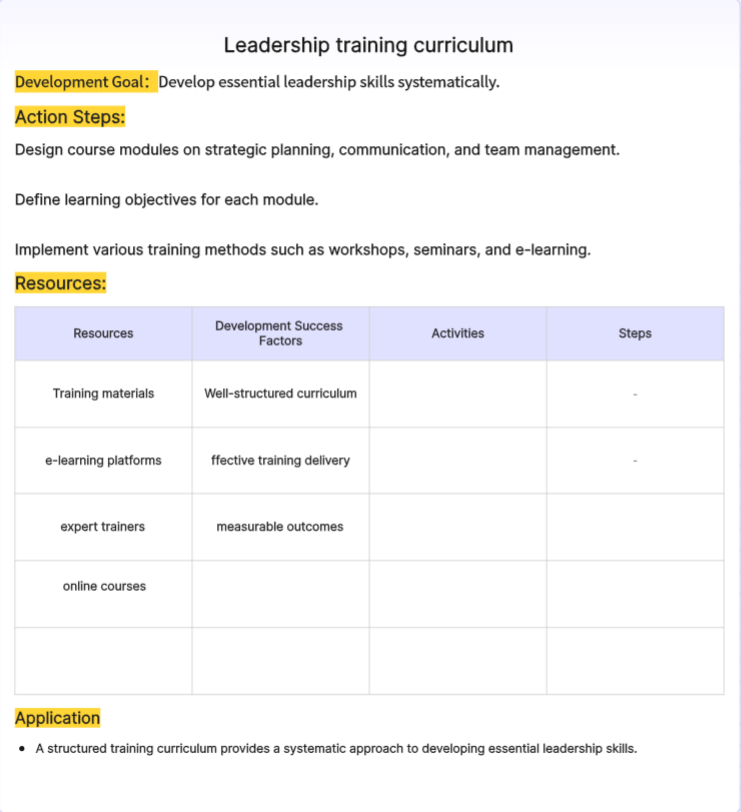
This template outlines a comprehensive training program designed to develop key leadership competencies. It includes:
Development Goal: Develop essential leadership skills systematically.
Action Steps:
- Design course modules on strategic planning, communication, and team management.
- Define learning objectives for each module.
- Implement various training methods such as workshops, seminars, and e-learning.
Resources: Training materials, e-learning platforms, and expert trainers.
Development Success Factors: Well-structured curriculum, effective training delivery, and measurable outcomes.
Application: A structured training curriculum provides a systematic approach to developing essential leadership skills.
Tips of creating leadership development plan template
Creating a Leadership Development Plan template can be an invaluable step in nurturing the leaders of tomorrow within your organization. Here are some tips to guide you through this process:
Identify Core Leadership Competencies: Start by defining what good leadership looks like in your organization. This might include skills like strategic thinking, emotional intelligence, effective communication, and the ability to inspire and motivate others.
Assess Current Skills: Conduct an honest assessment of the current skills of potential leaders. This could involve self-assessments, 360-degree feedback, or performance reviews.
Incorporate Flexibility: Allow for flexibility in the plan to adapt to changing organizational needs and individual development progress. And in any situation, you can change the content of the leadership development plan example.
Provide Support: Ensure that potential leaders have access to the resources and support they need to succeed. This could involve coaching, mentoring, or providing opportunities for networking and learning from others.
Measure Progress: Regularly measure and review progress against the development plan to ensure it remains on track and effective.
Foster a Culture of Continuous Learning: Encourage potential leaders to see this as an ongoing journey rather than a one-time event. Meanwhile, Keep updating of the leadership development plan template.
How to write your leadership development plan online?
Creating a Leadership Development Plan online can be streamlined using tools like Boardmix. Boardmix also can offer free leadership development plan template for you. Here’s how to utilize Boardmix for this purpose:
1. Sign Up and Set Up Your Account
Start by signing up for a Boardmix account and setting up your profile. Familiarize yourself with the platform’s features.

2. Choose a Template
Boardmix offers free leadership development plan templates that can be customized to fit your leadership development needs. Select a template that aligns with your objectives.

3. Customize the Template
Modify the free leadership development plan example to include specific goals, competencies, and action plans. Ensure it aligns with both organizational goals and individual development needs.
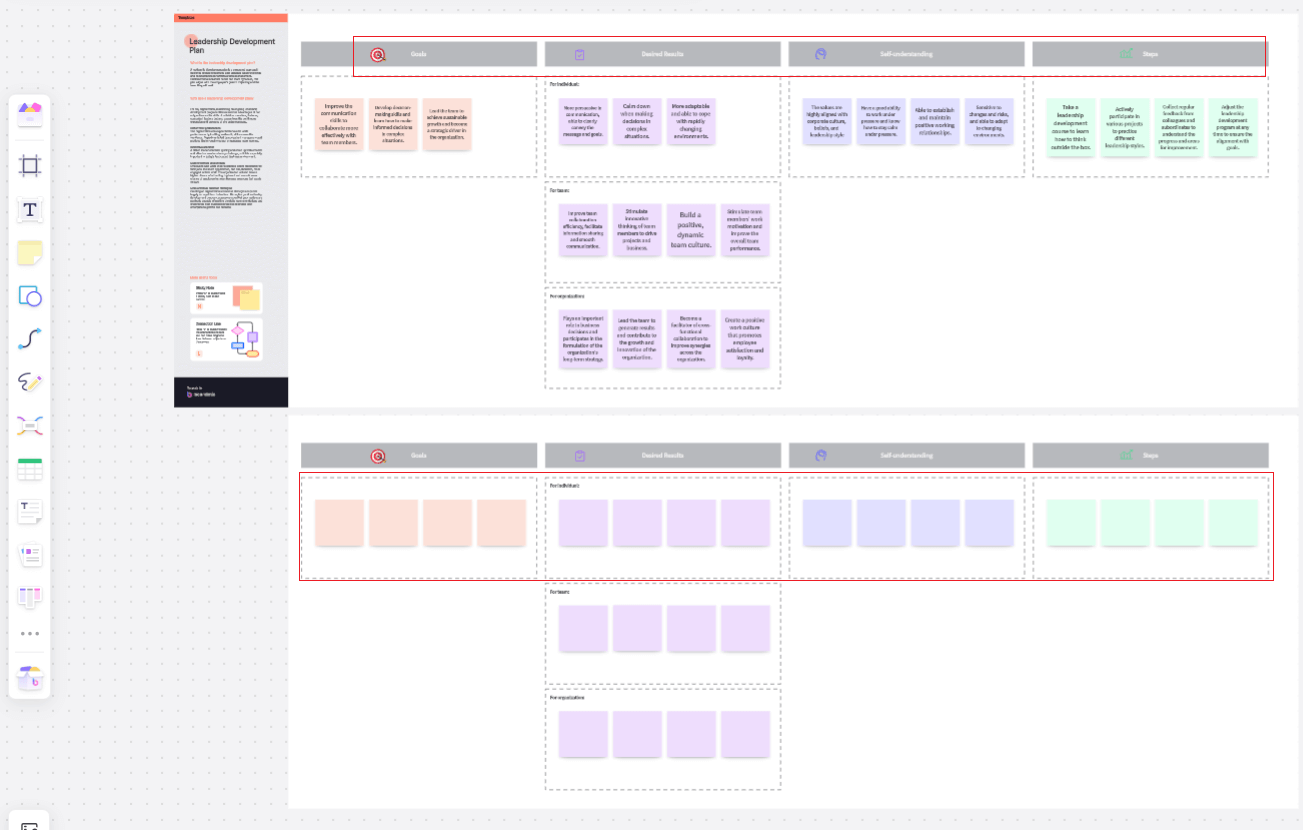
4. Add Stakeholders
Invite relevant stakeholders to collaborate on the plan. Boardmix allows for easy sharing and collaboration, making it simple to gather input and feedback.
5. Track Progress
Use Boardmix’s tracking and reporting features to monitor progress. Regularly update the leadership development plan example based on feedback and assessments.
6. Review and Revise
Periodically review the plan to ensure it remains relevant and effective. Make necessary adjustments based on the progress and changing needs of the organization.
By following these steps and leveraging the collaborative features of Boardmix, you can create a dynamic and effective Leadership Development Plan template that supports continuous growth and development.
In conclusion, crafting an effective Leadership Development Plan is pivotal for organizational success and long-term sustainability. Utilizing online tools like Boardmix can significantly streamline this process, providing a user-friendly platform for collaboration, customization, and continuous tracking. Boardmix's templates and features simplify the creation of comprehensive and dynamic leadership development plan templates, ensuring that your organization is well-equipped to develop capable leaders who can drive future success. By leveraging such innovative tools, businesses can enhance their leadership development initiatives, ultimately leading to stronger, more adaptive, and forward-thinking organizations.













